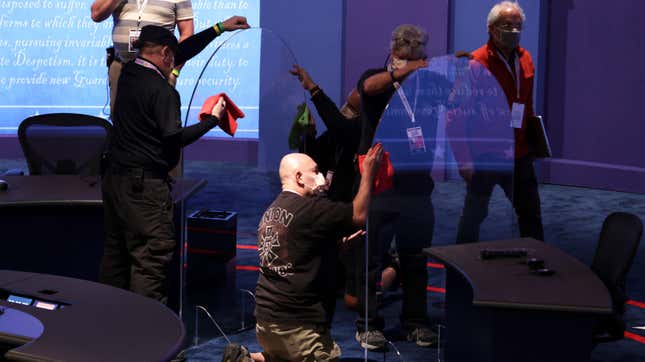Health Experts Agree This Plexiglass Barrier Is a Joke
Politics

On Wednesday night, Vice President Mike Pence and Senator Kamala Harris will meet at the University of Utah for their first and only debate of the 2020 election cycle. But they won’t be the only presence on the debate stage. They’ll be joined by moderator Susan Page of USA Today and two plexiglass barriers, intended to reduce the potential spread of covid-19.
Following President Trump and First Lady Melania Trump’s positive covid-19 diagnosis nearly one week ago, many White House players have tested positive as well: Press Secretary Kayleigh McEnany, adviser and speechwriter Stephen Miller, White House adviser Hope Hicks, former adviser Kellyanne Conway, Trump campaign adviser and former New Jersey Governor Chris Christie, and more. However, Pence and his wife have continued to test negative for the virus. Knowing this, Pence and Harris decided to proceed with the debate as scheduled, but the Harris camp had one demand: a solid barrier of protection between the two candidates.
It was a fair enough request following reports that Trump didn’t take a covid-19 test prior to the first presidential debate, relying on a faulty “honor system” instead. Given the announcement of Trump’s covid-19 diagnosis three days later and an unclear timeline as to when Trump last tested negative for the virus, Trump could have very well been asymptomatic but contagious during his debate against former Vice President Joe Biden. It’s a risk the Harris camp isn’t willing to take with Pence, who has not been quite as cavalier about the benefits of face masks as Trump, but has presented mask-wearing as a “personal choice.”
After initially opposing having a plexiglass barrier on his side of the stage—Pence spokeswoman and noted terrible human Karen Miller said, “If Sen. Harris wants to use a fortress around herself, have at it”— the Pence camp relented. But the plexiglass reveal has done little to ease concerns about viral spread. The Presidential Debate Commission confirmed that Pence and Harris’s desks are 12-feet apart, double the distance of the social distancing recommendations by the Centers for Disease Control and Prevention. Still, this is ice cold comfort: Photos of the barriers look somewhat unsubstantial to the naked eye. Upon seeing a photo of the setup, my colleague, Megan Reynolds, quipped, “I have been in nail salons with better barriers.
But it’s not just everyday observers who have their reservations.
-

-

-

-

-

-

-

-

-

-

-

-

-

-

-

-

-

-

-

-

-

-

-

-

-

-

-

-

-

-

-

-

-

-

-

-

-

-

-

-








































